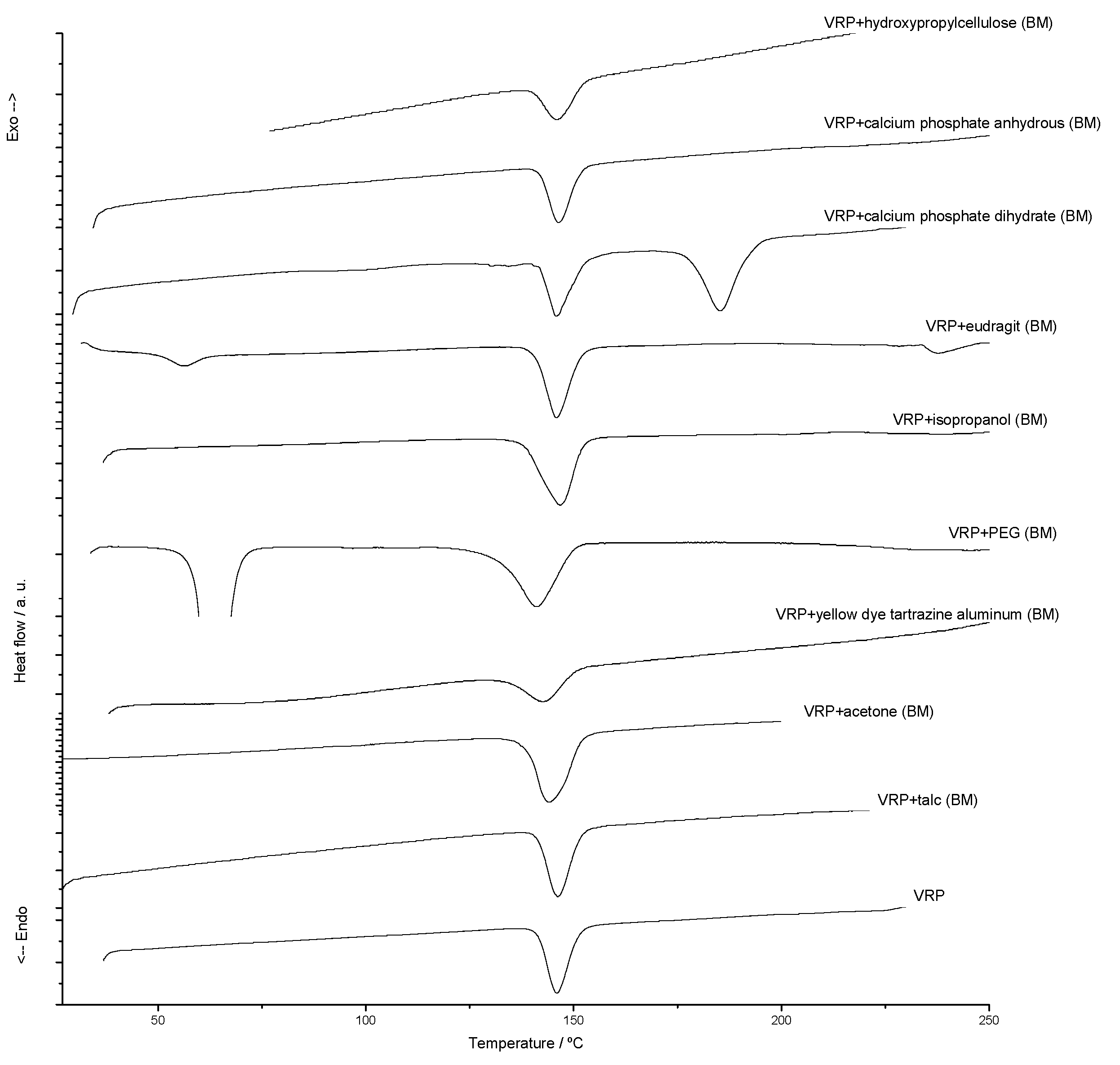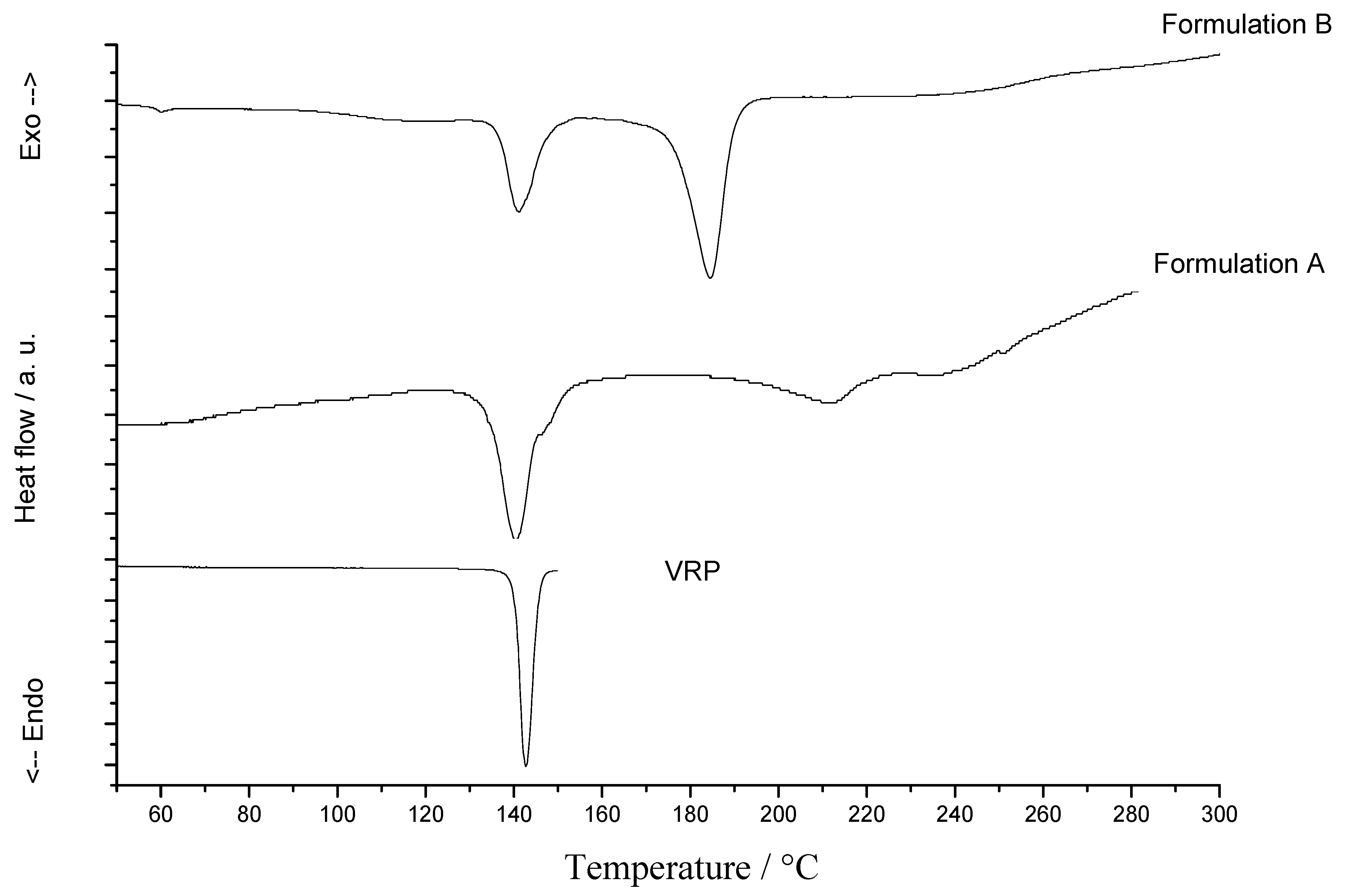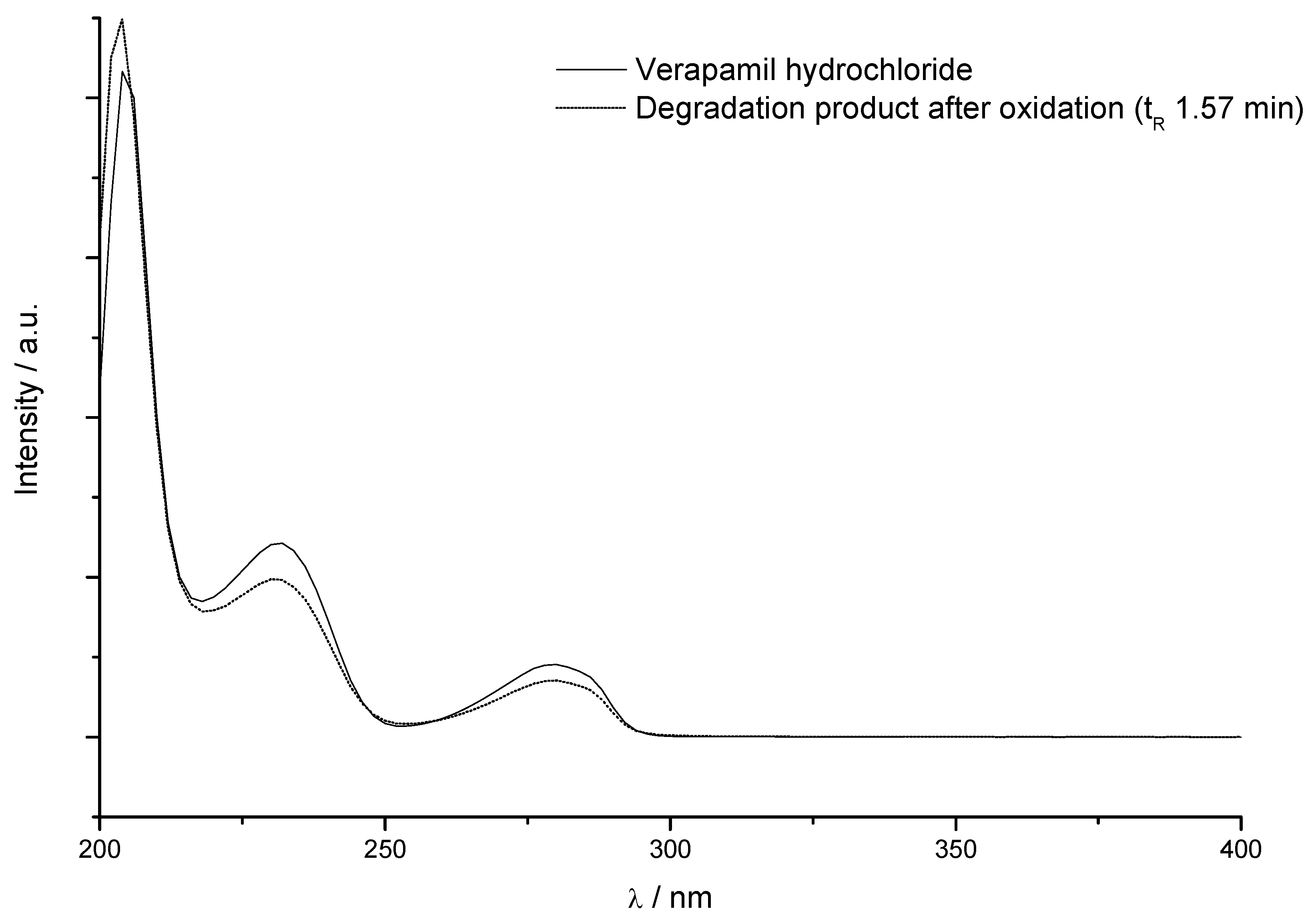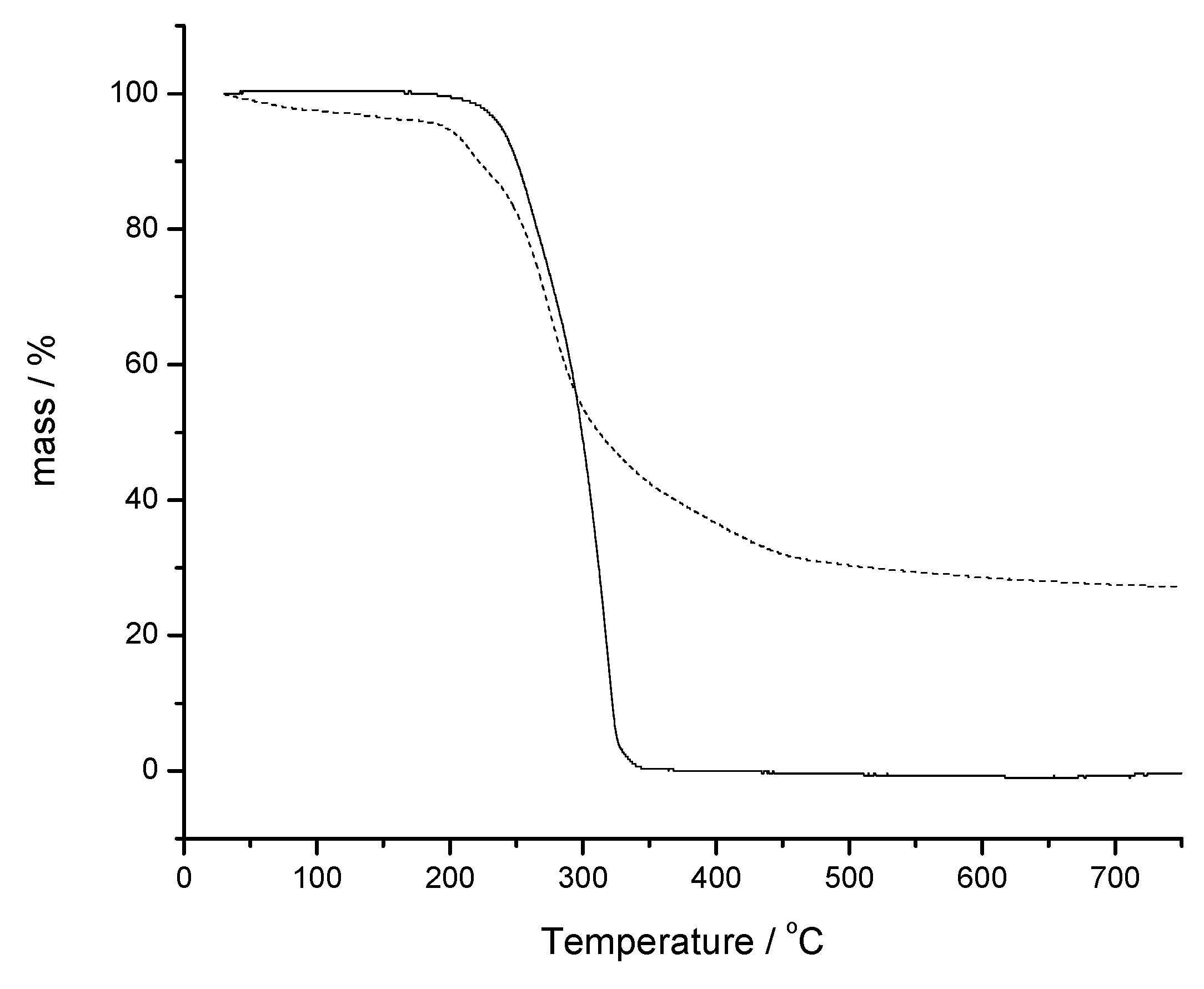Thermal Analysis Applied to Verapamil Hydrochloride Characterization in Pharmaceutical Formulations
Abstract
:1. Introduction

2. Results and Discussion
3. Experimental
3.1. General
4. Conclusions
Acknowledgments
References
- Craig, D.Q.M.; Reading, M. Thermal Analysis of Pharmaceuticals; CRC Press: New York, NY, USA, 2007; p. 400. [Google Scholar]
- Wendlandt, W.W. Thermal Analysis, 3rd ed.; John Wiley and Sons: New York, NY, USA, 1986. [Google Scholar]
- Gabbott, P. Principles and Applications of Thermal Analysis; Blackwell Publishing: Oxford, UK, 2008; p. 464. [Google Scholar]
- Caira, M.R.; Foppoli, A.; Sangalli, M.E.; Zema, L.; Giordano, F. Thermal and structural properties of ambroxol polymorphs. J. Therm. Anal. Calorim. 2004, 77, 653–662. [Google Scholar] [CrossRef]
- Freitas, M.N.; Alves, R.; Matos, J.R.; Marchetti, J.M. Thermal analysis applied in the osmotic tablets pre-formulation studies. J. Therm. Anal. Calorim. 2007, 87, 905–911. [Google Scholar] [CrossRef]
- Hassan, M.A.; Salem, M.S.; Sueliman, M.S.; Najib, N.M. Characterization of famotidine polymorphic forms. Int. J. Pharm. 1997, 149, 227–232. [Google Scholar] [CrossRef]
- Laszcz, M.; Kosmacinska, B.; Korczak, K.; Smigielska, B.; Glice, M.; Maruszak, W.; Groman, A.; Beczkowicz, H.; Zelazko, L. Study on compatibility of imatinib mesylate with pharmaceutical excipients. J. Therm. Anal. Calorim. 2007, 88, 305–310. [Google Scholar] [CrossRef]
- Leitão, M.L.P.; Canotilho, J.; Cruz, M.S.C.; Pereira, J.C.; Souza, A.T.; Redinha, J.S. Study of polymorphism from DSC melting curves: Polymorphs of terfenadine. J. Therm. Anal. Calorim. 2002, 68, 397–412. [Google Scholar]
- Macedo, R.O.; Nascimento, T.G.; Veras, J.W.E. Compatibility and stability studies of propranolol hydrochloride binary mixtures and tablets for TG and DSC-Photovisual. J. Therm. Anal. Calorim. 2002, 67, 483–489. [Google Scholar] [CrossRef]
- Oliveira, G.G.G.; Ferraz, H.G.; Matos, J.S.R. Thermoanalytical study of glibenclamide and excipients. J. Therm. Anal. Calorim. 2005, 79, 267–270. [Google Scholar] [CrossRef]
- Porter III, W.W.; Elie, S.C.; Matzger, A.J. Polymorphism in carbamazepina cocrystals. Cryst. Growth Des. 2008, 8, 14–16. [Google Scholar] [CrossRef] [PubMed]
- Stulzer, H.K.; Rodrigues, P.O.; Cardoso, T.M.; Matos, J.S.R.; Silva, M.A.S. Compatibility studies between captopril and pharmaceutical excipients used in tablets formulations. J. Therm. Anal. Calorim. 2008, 91, 323–328. [Google Scholar] [CrossRef]
- Schomerus, M.; Spiegelhaider, B.; Stieren, B.; Eichelbaum, M. Physiological disposition of verapamil in man. Cardiovasc. Res. 1976, 10, 605–612. [Google Scholar] [CrossRef] [PubMed]
- Fleckenstein, A. Specific pharmacology of calcium in myocardium, cardiac pacemakers, and vascular smooth muscle. Annu. Rev. Pharmacol. Toxicol. 1977, 17, 149–166. [Google Scholar] [CrossRef] [PubMed]
- Warmann, S.; Göhring, G.; Teichmann, B.; Geerlings, H.; Fuchs, J. MDR1 modulators improve the chemotherapy response of human hepatoblastoma to doxorubicin in vitro. J. Pediatr. Surg. 2002, 37, 1579–1584. [Google Scholar] [CrossRef] [PubMed]
- Budavari, S. The Merck Index, 12th ed.; Chapman&Hall/CRC: New Jersey, NJ, USA, 2000; version 12:3 [Cd-Rom]. [Google Scholar]
- Moffat, A.C.; Osselton, M.D.; Widdop, B. Clarke’s Analysis of Drugs and Poisons. In Pharmaceuticals, Body Fluids and Postmortem Material, 3 rd ed.; Pharmaceutical Press: London, UK, 2004; Volume 2, p. 1248. [Google Scholar]
- Singh, S.; Bakshi, M. Guidance on conduct of stress tests to determine inherent stability of drugs. Pharm. Technol. 2000, 1–14. [Google Scholar]
- Amidon, G.L.; Kasim, N.A.; Whitehouse, M.; Ramachandran, C.; Bermejo, M.; Lennernas, H.; Hussain, A.S.; Junginger, H.E.; Stavchansky, S.A.; Midha, K.K.; Shah, V.P. Molecular Properties of WHO Essential Drugs and Provisional Biopharmaceutical Classification. Mol. Pharm. 2004, 1, 85–96. [Google Scholar]
- FDA - Food and Drug Administration. Guidance for industry. In Dissolution Testing of Immediate Release Solid Oral Dosage Forms; CDER-FDA: Rockville, MD, USA, 1997; p. 17. [Google Scholar]
- British Pharmacopeia, 11th ed.; The Stationery Office: London, UK, 2007; [Cd-Rom].
- Stability testing of new drug substances and products Q1A(R2). In ICH Q1A (R2) - International Conference on Harmonization of Technical Requirements for the Registration of Drugs for Human Use, February 2003. Available at: http://www.ich.org/LOB/media/MEDIA419.pdf (accessed on 28 April 2009).
- Macedo, R.O.; Nascimento, T.G. Quality control of thiabendazole pre-formulation and tablets by TG and DSC coupled to the photovisual system. Thermochim. Acta 2002, 392–393, 85–92. [Google Scholar] [CrossRef]
- Mura, P.; Faucci, M.T.; Manderioli, A.; Bramanti, G.; Ceccarelli, L. Compatibility study between ibuproxam and pharmaceutical excipients using differential scanning calorimetry, hot-stage microscopy and scanning electron microscopy. J. Pharm. Biomed. Anal. 1998, 18, 151–163. [Google Scholar] [CrossRef]
- Nunes, R.S.; Semaan, F.S.; Riga, A.T.; Cavalheiro, E.T.G. Thermal behavior of verapamil hydrochloride and its association with excipients. J. Therm. Anal. Calorim. 2009, 97, 349–353. [Google Scholar] [CrossRef]
- Niazi, K.S. Handbook of Pharmaceutical Manufacturing Formulations: Compressed Solid Products; CRC Press: New York, NY, USA, 2004; Volume 1, p. 304. [Google Scholar]
- Balestrieri, F.; Magri, A.D.; Magri, A.L.; Marini, D.; Sacchini, A. Application of differencial scanning calorimetry to the study of drug-excipient compatibility. Thermochim. Acta 1996, 285, 337–345. [Google Scholar] [CrossRef]
- Bazzo, G.C.; Segatto Silva, G.C. Estudo termoanalítico de comprimidos revestidos contendo captopril através de termogravimetria (TG) e calorimetria exploratória diferencial (DSC). Braz. J. Pharm. Sci. 2005, 41, 315–322. [Google Scholar] [CrossRef]
- Cides, L.C.S.; Araújo, A.A.S.; Santos-Filho, M.; Matos, J.R. Thermal behaviour, compatibility study and decomposition kinetics of glimepiride under isothermal and non-isothermal conditions. J. Therm. Anal. Calorim. 2006, 84, 441–445. [Google Scholar] [CrossRef]
- Imprensa Nacional Casa da Moeda. Farmacopéia Portuguesa, 7th ed.; Imprensa: Lisboa, PT, USA, 2002; Version em Cd-Rom. [Google Scholar]
- The United States Pharmacopoeia, 31st ed.; United States Pharmacopeial Convention: Rockville, MD, USA, 2008.
- Rodrigues, P.O.; Cardoso, T.F.M.; Silva, M.A.S.; Matos, J.R. Aplicação de Técnicas Termoanalíticas na Caracterização, Determinação da Pureza e Cinética de Degradação da Zidovudina (AZT). Acta Farm Bonaer 2005, 24, 383–387. [Google Scholar]
- Kim, C. Advanced Pharmaceutics: Physicochemical Principles; CRC Press: New York, NY, USA, 2004. [Google Scholar]
Sample Availability: Samples of the compounds are available from the authors. |







| Temperature / °C | ORDER | |||
|---|---|---|---|---|
| Parameter | zero | first | second | |
| 190 | r | 0.9991 | 0.9961 | 0.9910 |
| k | 2.10 × 10-03 | 2.46 × 10-05 | 2.90 × 10-07 | |
| 200 | r | 0.9999 | 0.9967 | 0.9869 |
| k | 3.36 × 10-03 | 4.49 × 10-05 | 6.13 × 10-07 | |
| 210 | r | 0.9997 | 0.9841 | 0.9265 |
| k | 6.19 × 10-03 | 1.15 × 10-04 | 2.44 × 10-06 | |
| 220 | r | 0.9998 | 0.9862 | 0.9436 |
| k | 9.97 × 10-03 | 1.75 × 10-04 | 3.37 × 10-06 | |
| 230 | r | 0.9955 | 0.9966 | 0.9665 |
| k | 1.27 × 10-02 | 2.33 × 10-04 | 4.73 × 10-06 | |
| 240 | r | 0.9887 | 0.9996 | 0.9802 |
| k | 2.04 × 10-02 | 3.73 × 10-04 | 7.47 × 10-06 | |
| Temperature / °C | ORDER | |||
|---|---|---|---|---|
| Parameter | zero | first | second | |
| 200 | r | 0.9560 | 0.9647 | 0.9722 |
| k | 1.10 × 10-03 | 1.33 × 10-05 | 1.62 × 10-07 | |
| 205 | r | 0.9544 | 0.9643 | 0.9727 |
| k | 1.33 × 10-03 | 1.63 × 10-05 | 2.03 × 10-07 | |
| 210 | r | 0.9602 | 0.9697 | 0.9777 |
| k | 1.65 × 10-03 | 2.04 × 10-05 | 2.54 × 10-07 | |
| 215 | r | 0.9582 | 0.9700 | 0.9796 |
| k | 1.94 × 10-03 | 2.51 × 10-05 | 3.27 × 10-07 | |
| 220 | r | 0.9579 | 0.9715 | 0.9822 |
| k | 2.40 × 10-03 | 3.21 × 10-05 | 4.31 × 10-07 | |
© 2010 by the authors; licensee Molecular Diversity Preservation International, Basel, Switzerland. This article is an open-access article distributed under the terms and conditions of the Creative Commons Attribution license (http://creativecommons.org/licenses/by/3.0/).
Share and Cite
Yoshida, M.I.; Gomes, E.C.L.; Soares, C.D.V.; Cunha, A.F.; Oliveira, M.A. Thermal Analysis Applied to Verapamil Hydrochloride Characterization in Pharmaceutical Formulations. Molecules 2010, 15, 2439-2452. https://doi.org/10.3390/molecules15042439
Yoshida MI, Gomes ECL, Soares CDV, Cunha AF, Oliveira MA. Thermal Analysis Applied to Verapamil Hydrochloride Characterization in Pharmaceutical Formulations. Molecules. 2010; 15(4):2439-2452. https://doi.org/10.3390/molecules15042439
Chicago/Turabian StyleYoshida, Maria Irene, Elionai Cassiana Lima Gomes, Cristina Duarte Vianna Soares, Alexandre Frinhani Cunha, and Marcelo Antonio Oliveira. 2010. "Thermal Analysis Applied to Verapamil Hydrochloride Characterization in Pharmaceutical Formulations" Molecules 15, no. 4: 2439-2452. https://doi.org/10.3390/molecules15042439




